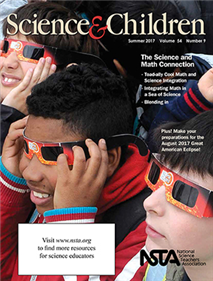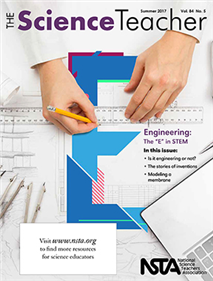All Resources
Journal Article
Toad-ally Cool Math and Science Integration
A summer science camp for girls teaches about herpetology while encouraging interest in science, technology, engineering, and math (STEM)....
Journal Article
Fourth graders predict and test how parental care improves offspring survivorship....
Journal Article
Integrating Math in a Sea of Science
Fourth-grade students learn through a fishy feeding frenzy!...
Journal Article
Why, How, and Where to View Totality
Make your plans now to experience the August 2017 Great American Eclipse!...
Journal Article
Editor's Note: The “Fundamental Tools” of Science
Science and Children’s editor shares thoughts regarding the current issue....
Journal Article
The Early Years: Taking Math Outside
This column discusses resources and science topics related to students in grades preK to 2. This month’s issue uses children’s interest in collecting outdoor objects to develop their number sense and to build their understanding of math concepts...
Journal Article
Teaching Through Trade Books: Becoming a Citizen Scientist
This column includes activities inspired by children’s literature. Both of this month’s activities focus on students identifying potential citizen science topics and contributing to actual research....
Journal Article
The Poetry of Science: The Math of Science
Building literacy in playful, meaningful ways. Use this poem to point out that scientists use clocks, timers, and stopwatches to collect and record information....
Journal Article
Science 101: Q: How Do Self-Driving Cars Work?
This column provides background science information for elementary teachers. This month’s issue discusses the science behind self-driving cars....
Journal Article
This column shares exercises to challenge content knowledge. This month's issue presents a new challenge and answers The Sound of One Hand Clapping challenge from last month....
Journal Article
Methods and Strategies: Ask the Right Question
This column provides ideas and techniques to enhance your science teaching. This month’s issue shows how teachers can use literature and higher-level thinking questions to enhance science instruction....
Journal Article
Engineering Encounters: The Internet of Things for Kids
This column presents ideas and techniques to enhance your science teaching. In the “Talking Window Garden” project, students create “smart” plant pots that use sensors to collect and analyze data on the health of their plants....
Journal Article
To bring engineering tasks into the classroom, know what qualifies—and what doesn’t. ...
Journal Article
Using engineering design to simulate cell transport processes....
Journal Article
Myths About the Nature of Technology and Engineering
Using the philosophy of technology and engineering to expose misconceptions....
Journal Article
An interdisciplinary, project-based unit for U.S. history students....
Journal Article
Using Troubleshooting Portfolios to enhance students’ science practices and concepts when doing engineering design....
Journal Article
Editor's Corner: Engineering for the Future
The Science Teacher’s editor shares thoughts on the current issue....
Journal Article
Science 2.0: Align Your Curriculum With the ISTE Standards
This column shares web tools that support learning. This month’s issue provides some scaffolding to help teachers align the ISTE standards to the example activities in our previous columns....
Journal Article
Focus on Physics: Sailing Into the Wind: A Vector Explanation
This column helps teachers build an understanding of physical principles. In this lesson, students discover surprising facts about sailing and also the intriguing usefulness of vectors....
Journal Article
Health Wise: Getting Their Names Right
This Q&A style column provides up-to-date information on current health topics—helping students (and teachers) make healthy choices. This month’s issue discusses why it is important to pronounce a student's name correctly....
Journal Article
Career of the Month: Civil Engineer
This column shares interviews with professionals using science in the workplace. This month’s issue describes Kristina Swallow's career path to becoming a civil engineer....
Journal Article
Right to the Source: View From the Top
Exploring science and history with the Library of Congress. This month's issue discusses the rise of skyscrapers....




